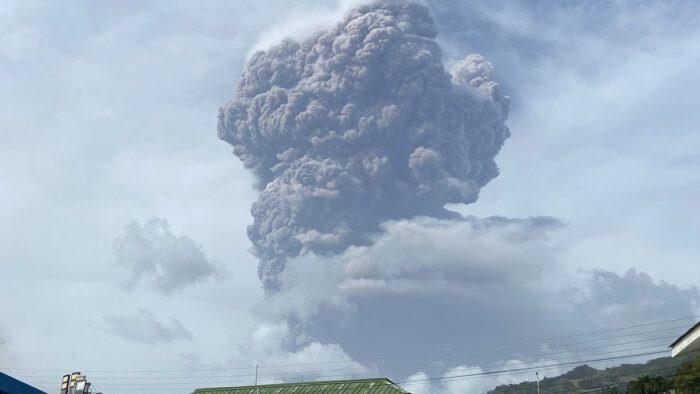By Observer
On April 22, iWitness News published a story in video, of an interview with a constituent and employer of the government from the North Windward area. He spoke in detail of his plight, seeking help to rebuild his home and to address some farming needs. That is two years after the 2021 volcano eruption. We refer to him here as an employer of the government because that is what voters do. They employ governments.
Parliament was called into session after the 2021 eruption to approve supplementary spending to respond to the disaster. A total of EC$117.8 million was allocated, of which EC$17 million was obtained locally, via local loans and the contingency fund. Another EC$12.7 million came in the form of grants. Then there was another EC$88 million in loans from different external institutions; all to address issues related the volcano eruption.
EC$12.5 million was allocated to the Ministry of Agriculture, to provide social assistance. EC$10.5 million of that amount was supposed to go towards providing income support for farmers; specifically, to 3,EC000 affected farmers, at $500 per month for sevenEC months. The remaining balance (EC$2m) was for food and care packages.
Ministry of National Mobilisation had EC$9 million for similar purpose — social assistance for affected persons.
Agriculture was also allocated another EC$5.5 million, to go towards direct production support for 3,000 farmers, in addition to support for farm equipment and supplies, water tanks, artificial insemination and so on.
Also, another EC$11.5 million was allocated to the Ministry of National Mobilisation, for the purpose of building materials and housing reconstruction.
The Ministry of National Security had another EC$1 million allocated to buy household appliances for affected persons. Even the police were to receive three new vehicles from an allocated amount of EC$500,000.
While at it, the Ministry of Transport and Works bucket was EC$40.7 million full, for general clean up, rehabilitation, and reconstruction. EC$1 million of that amount was to buy lands for resettlement of affected persons.
As you can probably determine, these are not all that were allocated. We thought we would stick to the ones that are related to the plight raised. We’re not going to suggest here that dealing with disasters is easy. Even with needle-threading logistics, some sort of fallout is expected. It’s worse when all cylinders are not firing; in this case, if all members of the communities are not involved as stakeholders, as they should.
In June 1979 — reported by the Trinidad Guardian — CARICOM struggled to find a host for its regional meeting. Each country had some sort of excuse as to why it couldn’t host. SVG’s excuse was understandable. It was dealing with the fallout from the eruptions just two months earlier. In 1982, Hudson Tannis, then foreign minister in the Labour Party government, spoke about the need for agricultural diversification. The 1979 eruption had severely affected agricultural production, as the Barbados Sunday Sun reported. Then, in 1985 — reported by CANA news — both Government and Opposition backed a peaceful protest by Orange Hill estate workers after the estate was sold. The owners had apparently decided to sell after the 1979 eruptions damaged the estate, causing severe damage to crop (coconut, lime, bananas, eggplant, etc.), from which they struggled to recover.
Those were probably the least of the disruptions caused by the 1979 eruptions. After all, it is reported that two persons died. We say all that to suggest that disasters could have lasting impact. However, considering the monies allocated for supplementary spending in 2021 — as a response to the eruption — one must wonder why after two full years that there are still persons seeking assistance to that magnitude. One would expect that SVG today is more much advanced and efficient than it was in 1979.
If all these amounts were properly and accurately estimated and should have covered all the intended support needs, then it stands to reason that perhaps the government has a capacity problem; meaning that it cannot spend an allocated amount of that size in two years. That’s assuming that some people were not excluded from benefits on purpose. Why, after two years, we have a family who have seemingly been severely affected, and is yet to receive the necessary support? This is two years since the eruption. What could be the reason? Let us hope that all those affected by the eruption would all receive the support they need, so that lives can return to (or better) pre-eruption comfort levels.
The opinions presented in this content belong to the author and may not necessarily reflect the perspectives or editorial stance of iWitness News. Opinion pieces can be submitted to [email protected].







One thing is for certain, there are more questions than answers. Accountability, transparency, integrity are among some of the core values of the National Liberation Movement.
D. Charles.
Thanks to this writer, to highlight this matter this person is from my community and still nothing has started for him. I am keeping an open eye on this one
This is an issue the representative – NDP can address to show Daniel didn’t take care of his constituency. The NP should also call on the government to show where the money was spent and the results.
What s in darkness will someday come to light and whatever is hidden will one day be exposed it’s all about time, only time alone will tell.